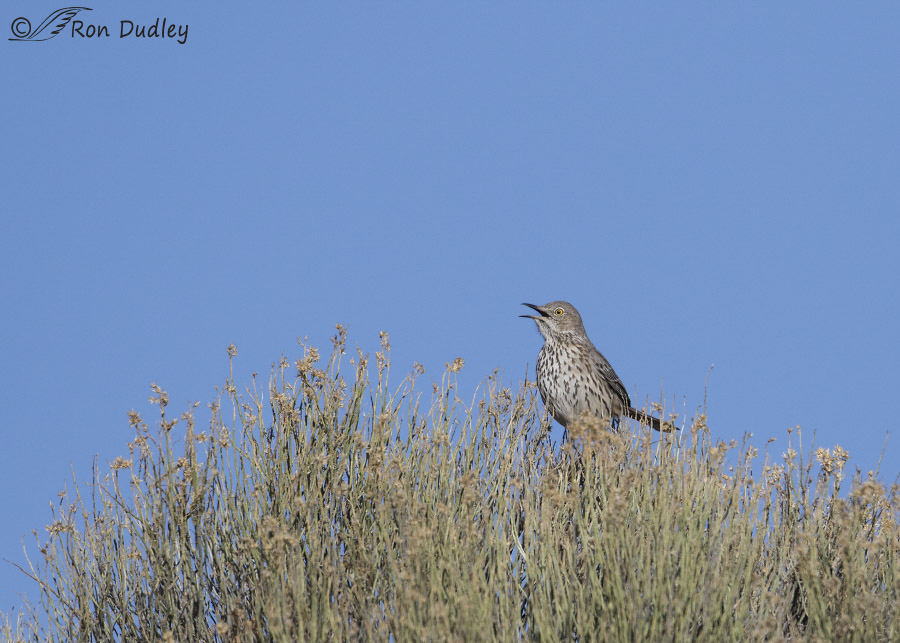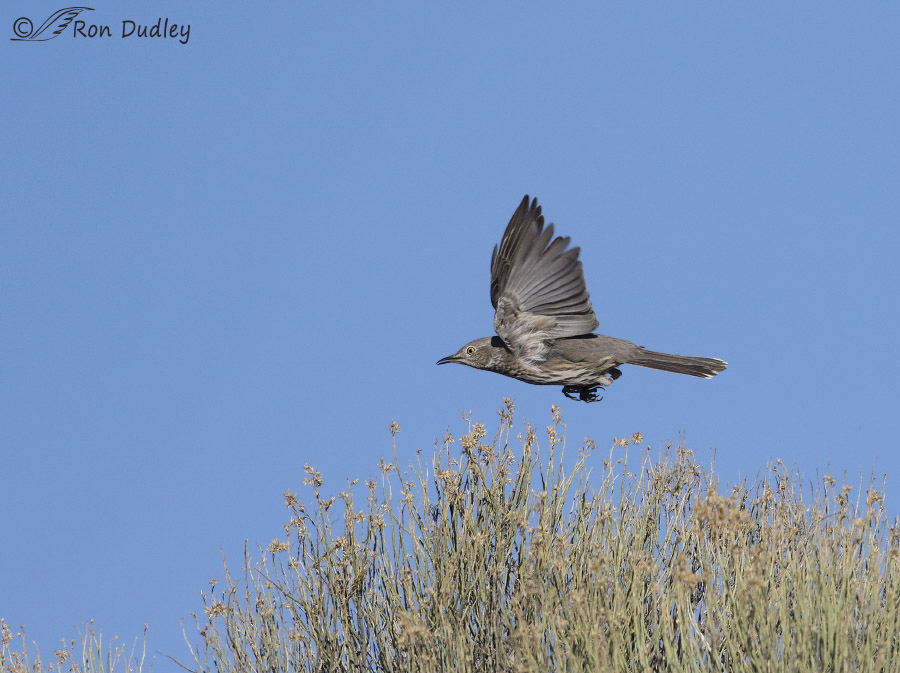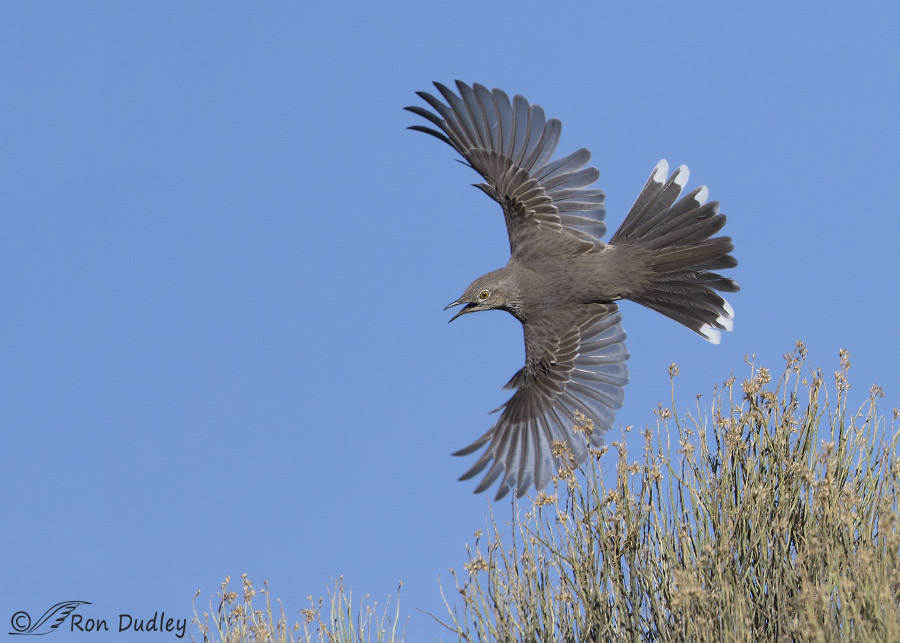Yet another example of the role of Lady Luck in bird photography.

1/4000, f/6.3, ISO 500, Canon 7D Mark II, Canon EF500mm f/4L IS II USM +1.4 tc, not baited, set up or called in
I photographed this Sage Thrasher three days ago in Wayne County, Utah. The bird wasn’t very close but I was enjoying its melodious song and as I did so I decided to watch it through my lens, partly because it was one of the few Sage Thrashers I found during the entire 5 day camping trip. The only chance I had for an interesting image or two of the bird was at take-off and that chance was a long one, especially at this distance.
I’m providing these first two images primarily for context.

1/4000, f/6.3, ISO 500, Canon 7D Mark II, Canon EF500mm f/4L IS II USM +1.4 tc, not baited, set up or called in
Though the first shot after take-off was sharp and had a good wing position the bird was a little too small in the frame for my tastes. But in the next frame the thrasher pulled off one of those lightening-quick flight maneuvers that are so very difficult to capture.

1/5000, f/6.3, ISO 500, Canon 7D Mark II, Canon EF500mm f/4L IS II USM +1.4 tc, canvas added for composition, not baited, set up or called in
The bird did a quarter-turn in a nanosecond and I happened to catch a flight posture that I really like.
Every time I look at this series I’m duly impressed by how incredibly quick these birds are. By using one of the dried flower stems as a marker the viewer can determine how far the bird has traveled in the last two images. That distance is less than a body length, which I think is pretty impressive considering the dramatic change in flight posture. I won’t attempt to list all of the elements of luck involved with this shot but two of the primary ones were the head turn with open beak and good eye contact given the body position and the fact that this posture significantly increases the size of the bird in the frame.
And I’ll admit to a certain amount of satisfaction that I was able to get this shot without using a setup (something I never do). Many pro and advanced amateur bird photographers work with elaborate setups (bait, multiple artificial perches, electronic calls, flash and even artificial backgrounds) with results similar to this image as their goal. Examples of setup bird photography can be seen in these two video clips – finch setup and woodpecker setup. The clips aren’t short but some may have the interest anyway.
Personally, I prefer to go “au naturel” even though it significantly reduces my chances of getting an image like this and increases my reliance on Lady Luck. After all, “nature” photography is my goal…
Ron


Always impressed with your in-flight action shots.
Beautiful capture on the rapid turn posturing. In my opinion I think it speaks to a photographers skill level and passion for a challenge when no assistance is required in order to obtain ones desired affect. I figure that if you get exactly the shot you want by “stacking the deck” eventually there will be nothing left to continue trying for. Society is turning into one of immediate gratification and it saddens me. The longer it is necessary to achieve a shot that you are happy with the more suprises you discover in your surroundings. During a time I was waiting in a certain area to see if a fox family would appear with their new kits, I discovered a pair of Spruce Grouse with one of their young quietly going about their business in the scrub brush. I captured some great shots of all three members of that species, by simply quietly roaming the area. Three lifers all in one moment. Some people don’t get the connection between the words nature and natural. Okay I’m done now. LOL
I’m interested in the aerodynamics of that thrasher’s turn. It looks like it had all available feather area expanded and used in the quarter turn. Can anyone here expand on that and relate it to airplane flaps?
Wow! What sensational shots Ron, thanks for sharing!
Charlotte
Wow! What sensational shots Ron, thanks for sharing!
Charlotte
Oooooh. And ahhh.
Set-ups are the province of wanna-be’s and fakes.
And don’t stir my heart and create a choreography of happy dances.
They don’t stir my heart either, EC – yet another thing we agree on.
I give up…
Don’t ever give up, Patty!
I love that last shot. How fun!
Susan Stone (AKA “ROCKY”) nailed it when she said “you capture their personalities”. That’s one of the major reasons what you accomplish is so different….and the most interesting (along with youe comments)…Evil iPad syrikes again. That was suppsed to tead “beauty”–not “besity”…Jeez!!!
Thank you, Patty.
That last shot is simply amazing. I was able to check the flower stalks and see the short distance involved (didn’t think I’d be able to). The last time I watched a video about setups, it got me upset, so I won’t be looking at these. It’s sad to see the conflict between ego and ‘nature’ photography, which requires the ego to win out. I much prefer your approach. As I recall, when I looked at the photos that resulted from the last set up link, I did not like any of them, because they looked artificial. You, on the other hand, routinely capture the personalities of the birds you photograph, which is a major reason I enjoy your blog so much. As do many others who have discriminating taste, based on the comments you get. I have a feeling that Lady Luck will smile on you more often with your new camera.
Susan, there’s another element often involved with doing setups – money. Many of these folks make their living by offering workshops and selling ebooks etc that promote setup photography. Beginning photographers see those beautiful images (and many are truly beautiful) and want to learn how to do it the lazy way. And typically these photographers don’t disclose their methodology to those who buy their images (folks who are usually naïve about such methods)
Nope, I’m no fan of setups.
What a “STUNNER” ! Congratulations–it’s great to see a payoff for your dedication and patience….
Thanks very much, Kris.
Just how lucky can you get! That last shot, the result of luck, patience, experience and great equipment is a real gem…the arc of the wings, the fanning of the tail, the open beak…obviously calling…WOW!!! It reminds me of another besity you took sometime before–of a Magpie, wings fanned, in all its iridescent glory. LOVE it!!!
Patty, if you spend enough time at it the variety of luck has to turn from bad to good occasionally. And I’ll take the latter whenever I can get it! Thank you.
Awesome shot. It triggered this idea that would simplify sorting images after an outing. Synchronize the time on your camera with the time on a device that records heart rate. Use those associated with the highest heart rates as standards for culling the remainder.
Dave, I still have 3392 images to cull from my trip. I suspect that my heart rate will match that of an elephant during most of my culling time but I sure do look forward to that occasional spike…
Using a setup makes everything under control. What is the fun of it?
The true joy is being there wishing that Lady Luck will be nearby.
Thanks for sharing this beauty.
I agree, Jorge. Setups seem more like studio photography than nature photography to me.
Exactly.
And after almost 36 years doing it I think I have enough.(three more years still)
I agree, WOW!!!!
That had to have been pure joy on your part to catch that shot!
Congratulations!!
“That had to have been pure joy on your part to catch that shot!”
That pretty much describes it, Dick. Because I was using my laptop on the road I wasn’t sure how sharp it was initially but I was very happy with the image when I put it on the better screen at home. Thank you.
WOW!
Thank you, Suze.
Another FABULOUS Triptych! As always… thank you for taking us along. CJ
Thanks very much, CJ.